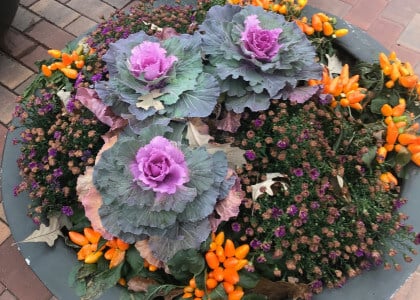
As the sweet corn begins to tassel out and the garden tomatoes start ripening, it’s a perfect time of the year to talk about edible landscaping. This practical approach integrates food plants with ornamental or decorative plants in your landscape. It’s a great way to enjoy fresh homegrown fruits, vegetables, and herbs. Our Design Studio created an edible landscaping design for the McKay Nursery headquarters. First, we chose a convenient location outside our employee kitchen. Then we started with a design plan for a smaller space integrating strawberries, serviceberries, aronia berries, beans, tomatoes, and thyme. This manageable plan leaves room for expansion over the next several years. The design also incorporates homemade teepee trellises. A trellis saves space and keeps vining plants like beans and tomatoes off the ground. Keeping vining plants off the ground helps produce more fruit/vegetables and helps to prevent insect damage and disease.
Edible landscapes apply the same design principles while substituting edible plants such as lettuces, blueberries, vegetables, and fruit trees for ornamental plants. Berry bushes work excellent to replace ornamental shrubs. McKay grows many ornamental shrubs, including cultivars of amelanchier, aronia, and prunus, which produce delicious fruit. Blueberries are beautiful shrubs that can be utilized very effectively and can be an integral feature in any residential ediscape. Not only grown for their delicious yet nutritious fruit, but they also add great seasonal interest with creamy white flowers, attractive foliage, and fantastic fall color. Strawberries are a lovely and tasty way to cover big open spots in the garden. For borders, lettuces work well and prefer filtered sun locations. Additionally, you may consider planting other edible fruit trees in place of flowering crabapple trees. Cherry trees have beautiful flowers and delightful fruit, especially for making a delectable cherry pie!
A few edible landscaping tips to follow:
- Always start with a landscape design plan to make planting easier and keep things organized
- Choose plants that you enjoy eating
- Be patient as new plants take a few years to become established for a good harvest
- Choose appropriate plant sizes for the space and properly prep the soil
- Start small and simple with a master design that you can add on every season
- Do your homework to understand which parts of the plants are edible and which parts may be poisonous

